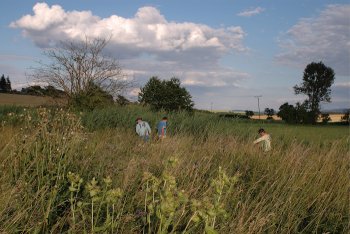Taken Off
The subject of Tomáš Pospěch’s photographs from the last four years, made mainly in spring and autumn, is football in the countryside. These photos, however, have little or no excitement, no stands full of spectators, no large-screen televisions, no advertising round the perimeter, no celebrities. They show sports matches with the highlights ’turned inside out’. About nothing decisive, these frozen moments are like the space between film frames. They create some kind of filler between the fast-action moments of the match and they shift the photographic message far beyond the usual bounds of football photography. Instead of using a telephoto lens, Pospěch has used a wide-angle. Instead of capturing motion, he has captured moments of waiting, pressing his shutter release only at the instant the ball is no longer in the shot. He has selected and printed only photos that a sports photographer would usually discard without a second thought. The subject has in this case slipped free of its genre.
The football pitches spreading out on the edges of villages (very often in fields, behind collective farms, at airfields, next to cemeteries) are for the most part naturally set into the landscape. These meadows that have been made geometric, often delimited from the surrounding landscape solely by white stripes painted on to mown grass, bring to mind territories covered with huge nets. Paradoxically, sometimes the goals lack nets, and, consequently, the ball occasionally flies between the goalposts and out into the countryside – into another space, another genre, another game, from which it won’t be passed back to the players. It is this theme of the encounter with Nature, in the search for the lost ball that has rolled off into the bushes, floated downstream, or been swallowed by a wood, that at first makes Pospěch’s documentary set seem to merge with meditative, timeless landscape photography.
It’s impossible not to notice that the photographer, even in the space of the secondary action, has paid little attention to capturing emotion – joy, relief, or disappointment – in the faces of the players. The footballers are depicted as chess players on a green board. They await the next move. The action of the match, however, slips through the cast net. The ’indecisive moment’ determines the coordinates of the current state of inaction, not the result. In time and space, the current state is ’taken off’.
Lucia L. Fišerová
Tomáš Pospěch (b. 1974) is an art historian, photographer, artist, free-lance curator, and teacher at the Institute of Creative Photography, Silesian University, Opava. He lives in Prague and Hranice. He received a Master’s degree from the Institute of Creative Photography in 1998 and a Master’s in Art History from Charles University, Prague, in 1999. His main professional interests are photography and the fine arts of central Europe. He is the author of more than twenty books, including monographs on Vladimír Birgus and Jindřich Štreit as well as on contemporary Slovak documentary photography, and the volume Czech and Slovak Photography of the 1980s and 1990s, which accompanied an exhibition of the same name. Among the exhibitions he has organized are a retrospective of the work of Jindřich Štreit (held at the Slovak National Gallery, Bratislava, 2006, and the City Gallery Prague, 2007). His articles appear regularly in Ateliér, Fotograf, Imago, Fotografie Magazín, Photonews, Camera Austria, and Reflex. He has taken the more conceptual approach in his own recent photographs – Castle Owners (2002–05), Landscapes.jpg (2002–05), An Aimless Walk (2004–08), and Castles and Châteaux of the Czech Republic (2004–05, 2009) – in which he works freely with the landscape genre. He is the winner of the 2006 sittcomm.award.









![[img] Tomáš Pospěch:Bezúčelná procházka/Aimless walk, vernisáž(1) zleva:Tomáš Pospěch, Lucia L.Fišerová, Miloš Vojtěchovský](../../sites/default/files/styles/very_small/public/event/2010/100112151209.jpg)
![[img] Tomáš Pospěch:Bezúčelná procházka/Aimless walk, vernisáž(2), Tomáš Pospěch](../../sites/default/files/styles/very_small/public/event/2010/100112151511.jpg)
![[img] Tomáš Pospěch:Bezúčelná procházka/Aimless walk, vernisáž(3)](../../sites/default/files/styles/very_small/public/event/2010/100112151923.jpg)